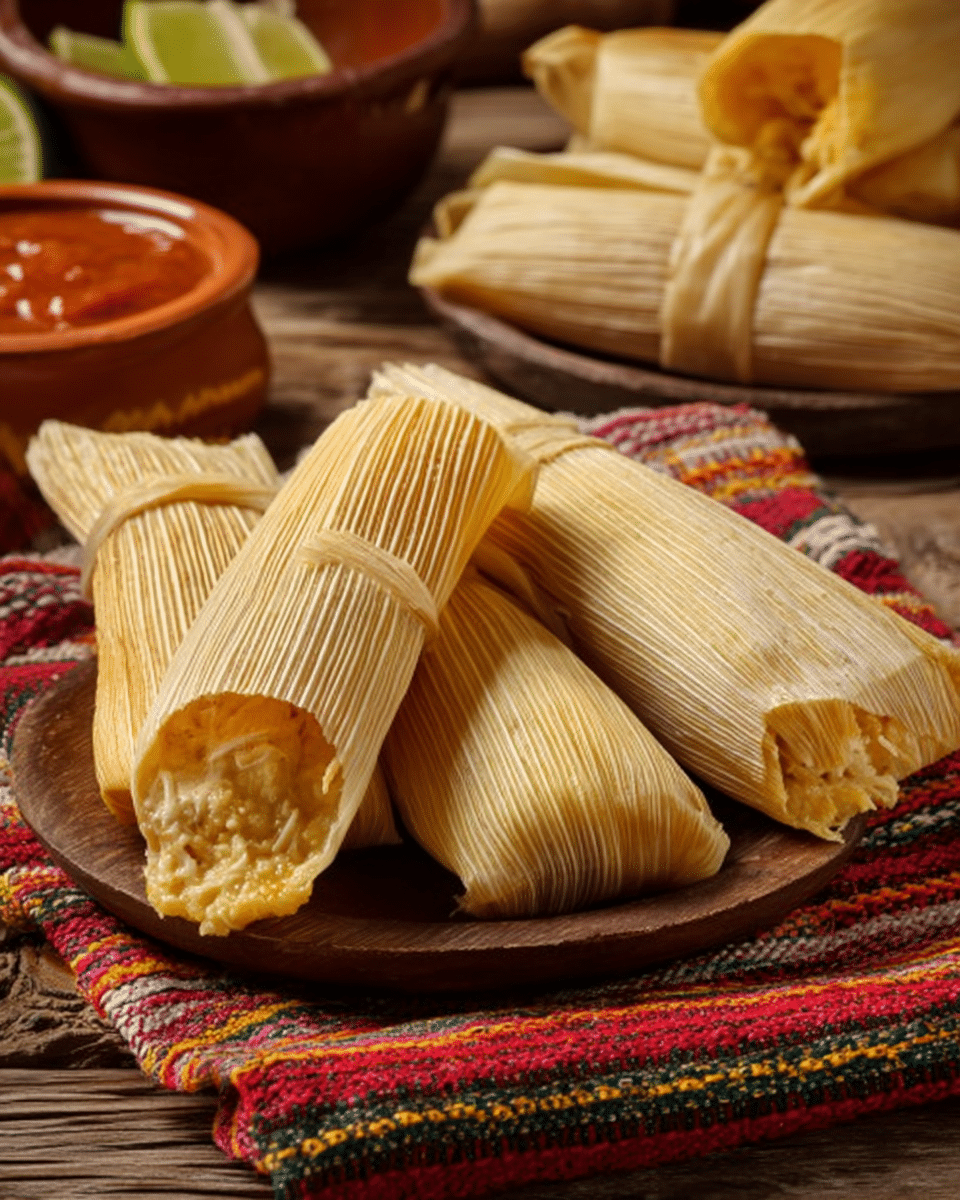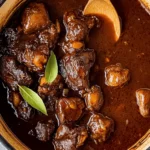Tamales de Elote (sweet corn tamales) and Tamales de Puerco (savory pork tamales) are iconic Mexican dishes that hold a special place in holiday and festive meals, especially during Mexican Independence Day. Wrapped in corn husks and steamed to perfection, tamales represent community, family, and tradition, often made in large batches with loved ones.
FULL RECIPE
Ingredients
1.For the Tamales de Elote (Sweet Corn Tamales):
- 6 cups fresh corn kernels (about 6–8 ears)
- 1 cup masa harina
- 1/2 cup unsalted butter, softened
- 1/2 cup sugar (adjust to taste)
- 1/2 teaspoon baking powder
- 1/4 teaspoon salt
- 1/2 cup whole milk
- Corn husks (soaked in warm water until pliable)
2.For the Tamales de Puerco (Pork Tamales):
- 2 lbs pork shoulder, cut into chunks
- 1/2 onion
- 2 garlic cloves
- Salt, to taste
- 4 dried guajillo chiles
- 2 dried ancho chiles
- 2 Roma tomatoes
- 1/4 teaspoon ground cumin
- 1/2 teaspoon oregano
- 2 tablespoons lard or vegetable oil
3.For the Masa (Dough) for Pork Tamales:
- 4 cups masa harina
- 2 teaspoons baking powder
- 1 teaspoon salt
- 1 cup lard or vegetable shortening
- 2–2½ cups pork broth (from cooking the pork)
- Corn husks (soaked in warm water until pliable)
Directions
- Prepare the Corn Husks:
Soak corn husks in warm water for 30–60 minutes until soft. Rinse and drain before using. - For Sweet Corn Tamales:
Blend corn kernels until smooth. In a large bowl, beat butter and sugar until fluffy. Add masa harina, baking powder, and salt. Mix in the corn puree and milk until a soft, spreadable dough forms. Adjust sweetness if needed. - Assemble Sweet Corn Tamales:
Spread 2–3 tablespoons of corn mixture onto the center of a corn husk. Fold the sides in, then fold the bottom up. Set aside, seam side down. - Cook the Pork for Savory Tamales:
In a pot, place pork, onion, garlic, and salt. Cover with water and simmer until the meat is tender (about 1.5–2 hours). Shred the pork and reserve the broth. - Make the Red Chile Sauce:
Toast guajillo and ancho chiles, then soak them in hot water for 15 minutes. Blend with tomatoes, cumin, oregano, and a bit of reserved pork broth. Strain and sauté in oil or lard for 10 minutes. Add shredded pork and cook until well combined. - Prepare the Masa for Pork Tamales:
In a bowl, mix masa harina, baking powder, and salt. In another bowl, beat lard until fluffy. Gradually mix in the dry ingredients and pork broth until the masa is soft, moist, and holds its shape when spread. - Assemble Pork Tamales:
Spread about 2 tablespoons of masa on a corn husk. Add 1 tablespoon of pork filling in the center. Fold the sides and bottom, and set aside seam-side down. - Steam the Tamales:
Place tamales upright in a large steamer with the open end facing up. Steam over medium heat for 1 to 1.5 hours, checking water level occasionally. Tamales are done when the husk peels away easily from the masa. - Serve:
Let tamales rest for 10 minutes after steaming. Serve sweet corn tamales as-is, or with crema. Serve pork tamales with salsa or beans.
Nutrition Facts
- Calories: 250 (sweet) / 300 (pork)
- Protein: 4g (sweet) / 10g (pork)
- Fat: 12g (sweet) / 18g (pork)
- Saturated Fat: 6g (sweet) / 7g (pork)
- Carbohydrates: 34g (sweet) / 28g (pork)
- Fiber: 3g (both)
- Sugars: 6g (sweet) / 2g (pork)
- Sodium: 190mg (sweet) / 270mg (pork)
Historical Importance of Tamales in Mexican Culture
Tamales are deeply woven into the culinary and cultural fabric of Mexico, dating back to pre-Hispanic times when indigenous civilizations like the Aztecs and Mayans prepared them for feasts, rituals, and warriors on the go. Over centuries, tamales evolved regionally, with each community adopting its own fillings, masa textures, and wrapping methods. During Mexican Independence Day, tamales—especially Tamales de Elote and Tamales de Puerco—are a staple at family gatherings, symbolizing unity, celebration, and tradition passed down through generations.
Flavor Profiles: Sweet vs. Savory
Tamales de Elote and Tamales de Puerco offer a unique contrast in taste and texture, making them ideal for serving side-by-side. The sweet corn tamales are soft and subtly sweet, with a natural earthiness from the fresh corn and masa. On the other hand, pork tamales are hearty and richly seasoned, filled with tender shredded pork coated in a robust red chile sauce. Together, they offer a well-rounded sensory experience—light and indulgent, mild and spicy, soft and satisfying.
Nutritional Value and Dietary Considerations
Though tamales are comfort food, they can be surprisingly balanced. Sweet corn tamales are rich in fiber and natural sugars from the corn, and can be made with less fat and sugar to suit dietary needs. Pork tamales are protein-rich and provide essential nutrients like iron and B vitamins, especially when using high-quality pork. For a lighter version, home cooks can reduce lard or use plant-based oils, and incorporate vegetables into the masa or filling. Gluten-free and easily adaptable, tamales can be tailored for various dietary preferences.
Common Variations Across Regions
Tamales vary widely across Mexico depending on local ingredients and culinary traditions. In the Yucatán, tamales are wrapped in banana leaves instead of corn husks, while in Oaxaca, mole tamales are a regional favorite. For Tamales de Elote, some versions include added cheese or sweetened condensed milk for richness. For Tamales de Puerco, regional sauces may use different chili blends, such as chipotle or pasilla, giving the dish a smoky or deeper flavor. Each variation tells a unique story of Mexico’s regional identity and culinary diversity.
Tips for Assembling and Steaming
The process of making tamales is both an art and a social event. Soaking the corn husks properly ensures flexibility for folding, while spreading the masa thinly and evenly is key for even cooking. Steam tamales upright, open-end up, and avoid overcrowding the pot to allow steam circulation. Checking the water level during steaming prevents burning. Done tamales will pull cleanly from the husk and have a firm yet tender texture. Making tamales with others—often called a “tamalada”—turns the process into a communal experience filled with music, stories, and tradition.
Pairing Suggestions for Serving
Tamales are incredibly versatile and pair well with a variety of traditional sides and drinks. Sweet corn tamales can be enjoyed with a drizzle of Mexican crema, cinnamon sugar, or a mug of atole. Pork tamales shine next to a side of refried beans, rice, or a smoky salsa. Drinks such as champurrado, hot chocolate, or agua fresca elevate the dining experience. Whether served for breakfast, lunch, or dinner, tamales adapt easily to the occasion and complement both sweet and savory additions.
Storage and Reheating Advice
Tamales store exceptionally well and are often made in large batches to be enjoyed over several days. Once cooled, they can be refrigerated for up to five days or frozen for several months. To reheat, steaming is ideal to retain moisture, but tamales can also be microwaved with a damp paper towel or lightly pan-fried for a crispy finish. For frozen tamales, it’s best to steam directly from frozen without thawing to prevent sogginess. Proper storage ensures tamales maintain their flavor and texture over time.
Creative Leftover Ideas
Leftover tamales can be repurposed into a variety of delicious dishes. Crumbled pork tamales can be sautéed and turned into a filling for tacos or breakfast burritos. Sweet corn tamales pair beautifully with fruit compote or whipped cream for a dessert twist. Tamales can also be sliced and grilled to create a crispy exterior, then topped with eggs for a Mexican-style breakfast. Using leftovers creatively reduces waste and offers a new way to enjoy this beloved dish.
Advertisement
Vegetarian and Vegan Adaptations
Tamales are easily customizable for vegetarian or vegan diets. For a plant-based version of Tamales de Puerco, the pork can be replaced with mushrooms, jackfruit, or textured vegetable protein (TVP), paired with the same flavorful chile sauce. Vegan masa can be made with vegetable shortening or coconut oil, and sweet corn tamales can use plant-based milk and margarine. These adaptations allow more people to enjoy tamales while staying true to traditional flavor profiles and methods.
Conclusion
Tamales de Elote and Tamales de Puerco are more than just delicious dishes they are a symbol of Mexican culture, resilience, and family connection. Their preparation brings people together, their flavors tell stories of regions and traditions, and their versatility makes them a timeless favorite. Whether you’re celebrating a national holiday or simply gathering with loved ones, tamales transform any meal into a moment of celebration.






